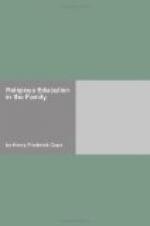My God, I thank thee thou
hast made
This earth so bright....,
and so beauty and joy become part of his religion. His faith becomes a gladsome thing; he knows that the trees of the forest clap their hands, the mountains and the hills sing, and the morning stars chant together in the gladness of the divine life.
Such a view of the world comes not by prearranged and indoor interviews. One must walk out into the good outdoor world for the opportunity and the inspiration. The garden plot, the park, and, best of all, the open fields and woods speak to a child and furnish us an open book from which we may teach him to read. Recalling religious impressions, the writer would testify to feeling nothing deeper, as a result of church attendance in childhood, than the shapes of seats and the colors of walls; but there remain deep impressions of wonder, beauty, and the meaning of God from Sunday mornings spent with his father under the great beeches in Epping Forest, listening to the reading and singing of the old hymns, or joining in conversation on the woods and the flowers, and even on the legends of Robin Hood in the forest.
Sec. 6. THE EVERYDAY OPPORTUNITIES
Seventhly, natural conversation affords the best opportunity for direct instruction. A child is a peripatetic interrogation. His questions cover the universe; there are no doors which you desire to see opened that he will not approach at some time. There is great advantage when the religious question rises normally; when the child begins it and when the interest continues with the same naturalness as in conversation on any other subject. Then questions usually take one of three forms: mere childish, curious questions, questions on conduct, and questions on religion in its organized form.
The child’s curiosity is the basis of even those questions which have usually been credited to preternatural piety. The tiny youngster who asks strange questions about God asks equally startling ones about fairies or about his grandmother. But his questions give us the chance to direct him to right thoughts of God. Here we need to be sure of our own thoughts and to keep in mind our principal purpose, to quicken in this child loyalty to the highest and best. He must be shown a God whom he can love and, at the same time, one who will call for his growing loyalty, his courage, and devotion. Everything for the child’s future depends on the pictures he now forms. We all carry to a large degree our childhood’s view of God.
Some of the child’s questions probe deep; how shall we answer them? When you know the truth tell him the truth, being sure that it is told in language that really conveys truth to his mind. The danger is that parents will attempt to tell more than they know, to answer questions that cannot be answered, or that they will, in sloth or cowardice or ignorance, tell children untrue things. If




